German actor Willy Birgel (1891-1973) started his film career when he was already over 40. He was the charming grand seigneur of the Ufa films of the 1930s. Despite his many appearances in Nazi propaganda films, he became again a very busy film actor in the German cinema of the 1950s.
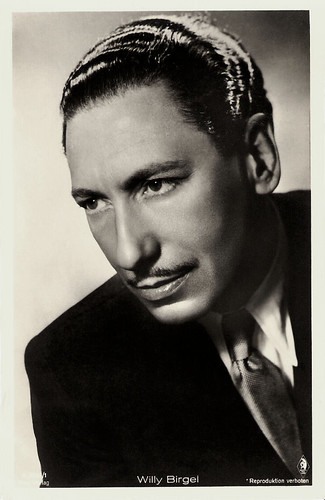
German postcard by Ross Verlag, no. A 2991/1, 1939-1940. Photo: Bavaria Filmkunst.
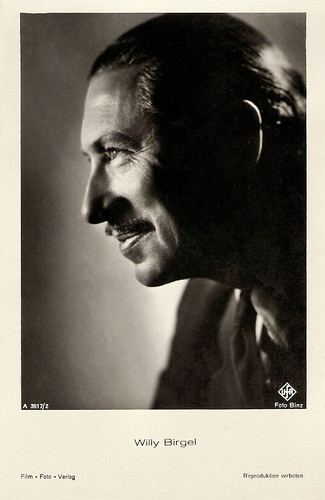
German postcard by Film-Foto-Verlag, no. A 3617. Photo: Ufa / Binz.

German postcard by Film-Foto-Verlag, no. A 3659/2. Photo: Ufa / Binz.
Wilhelm Maria (Willy) Birgel was born in 1891, in Köln (Cologne), Germany. He was the son of Johann Heinrich Birgel, a goldsmith and engraver, and his wife Henriette (born Dreyers).
Willy began his acting career in 1912 on the stage in Köln. In the following years he played in theatres in Bonn, Dessau, Köln and Koblenz. The first World War interrupted in 1915 his career and he was wounded while serving with a German artillery unit in Serbia. After the war he continued his stage career in the theatre of Aachen. In 1924 he became a company member of the Nationaltheater of Mannheim, where he had triumphs with roles like Faust and Mephistopheles in Goethe’s Faust I, Franz Moor in Schiller’s Die Räuber/The Robbers and the title characters in Shakespeare’s Hamlet and Richard III.
His film debut came rather late. He was already over forty years old before he got his first major film role as the English Camp Commandant in Ein Mann will nach Deutschland/A Man Wants to Get to Germany (Paul Wegener, 1934). This Ufa-production portrayed a German engineer (Karl Ludwig Diehl) living in South America who hears in 1914 of the war in Europe. He has only one thought: home to Germany to help a fatherland under attack. The film showed of the kind of German values that were emphasized in Nazi Germany.
Other films he made for the National Socialist Regime included Unternehmen Michael/The Private's Job (Karl Ritter, 1937), Feinde/Enemies (Viktor Tourjansky, 1940) with Brigitte Horney, and Kameraden/Comrades (Hans Schweikart, 1941). In 1937, Reichspropagandaminister Joseph Goebbels named Birgel Staatsschauspieler (Actor of the State), the highest honor for German actors at the time. Beside the propaganda films, he starred in several popular entertainment films becoming an unlikely public favorite.
Birgel had his first leading part in Fürst Woronzeff/Prince Woronzeff (Artur Robison, 1934). He appeared as a chivalrous aristocrat and distinguished gentleman in Das Mädchen Johanna/Joan of Arc (Gustav Ucicky, 1935) with Gustaf Gründgens and Heinrich George, in Schlussakkord/Final Accord (Detlev Sierck/Douglas Sirk, 1936) with Lil Dagover, and in Fanny Elssler (Paul Martin, 1937) with Lilian Harvey. Great successes were Zu neuen Ufern/To New Shores (Detlev Sierck/Douglas Sirk, 1937) and Der Blaufuchs/The Blue Fox (Viktor Tourjansky, 1938), both in which he appeared at Zarah Leander's side.
Meanwhile he also had success on stage at the Berliner Volksbühne. Till the end of the war he continued his career with films like Der Fall Deruga/The Deruga Case (Fritz Peter Buch, 1938), Maria Ilona (Géza von Bolváry, 1939) opposite Paula Wessely, Das Herz der Königin/The Heart of a Queen (Carl Froelich, 1940) with Zarah Leander, ...reitet für Deutschland/Riding for Germany (Arthur Maria Rabenalt, 1941), the Rudolf Diesel biography Diesel (Gerhard Lamprecht, 1942), and Der Majoratsherr (Hans Deppe, 1944).
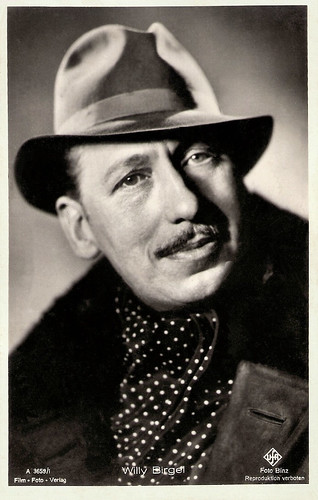
German postcard by Film-Foto-Verlag, no. A 3659/1, 1941-1944. Photo: Ufa / Binz.
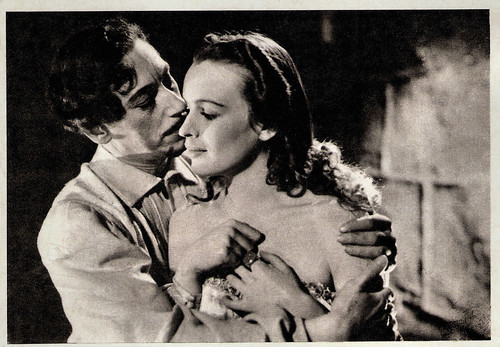
German postcard by Das Illustrierte Blatt. Photo: Ufa / Lindner. Publicity still for Das Herz der Königin/Mary Queen of Scots (Carl Froelich, 1940) with Lotte Koch.
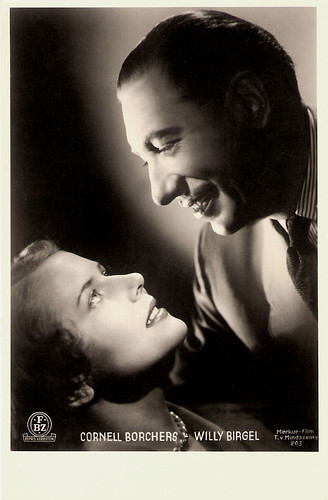
German postcard by FBZ, no. 225. Photo: Merkur-Film / T. v. Mindszenty. Publicity still for Das ewige Spiel/The eternal game (Frantisek Cáp, 1951) with Cornell Borchers.
After World War II, Willy Birgel was on the Allied black-list and did not make another film until 1947. Director Harald Braun and producer Erich Pommer offered him a role in Zwischen gestern und morgen/ Between Yesterday and Tomorrow (Harald Braun, 1947) with Hildegard Knef.
By the 1950s, he was back on the level of his pre-war popularity. He often appeared together with superstar Hans Albers, for example in Vom Teufel gejagt/Hunted by the Devil (Viktor Tourjansky, 1950). He specialized in supporting roles as the elderly grand seigneur and also of the father figure, and appeared in many Heimatfilms, for example Heidi (Luigi Comencini, 1952), and Johannisnacht/Midsummer Night (Harald Reinl, 1956) with Hertha Feiler.
In the 1960s, Birgel was able to make the transition to television. In the cinema he was seen in films like Frau Cheneys Ende/The End of Mrs. Cheney (Franz Josef Wild, 1961) with Lilli Palmer, and Sommersprossen/Beyond Control (Helmut Förnbacher, 1968). Interesting was Schonzeit für Füchse/No Shooting Time for Foxes (Peter Schamoni, 1966) in which Birgel made fun of his own image. The film won the Silver Bear of the Berlin Film Festival.
In 1966 Birgel himself won the Bundesfilmpreis, a honorary award for his continued outstanding individual contributions to the German film over the years. He was also awarded the Bambi award in 1960 and the Filmband im Gold award in 1964 and 1966. His last film was the Italian film Il Gesto/The Gesture (Marcello Grottesi, 1973).
Willy Birgel died in 1973 of heart failure, in Dübendorf, Zürich, Switzerland. He was buried in his birth city, Köln. Birgel was married twice: first to actress Carola Cajetan, with whom he had a son, and later to actress Charlotte Michael, with whom he had a daughter. Both his marriages ended in a divorce.
I loved this comment by Miss Mertens at one of our postcards at Flickr : "From my mother I know, that it was the biggest compliment in the 1940s, when somebody told a man: 'You are looking like Willy Birgel'."
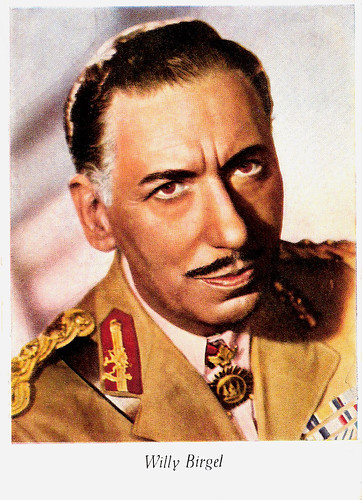
German postcard by Werbedrück Rudolf Stepanek, München. Photo: Gloria / Lilo. Publicity still for Sterne über Colombo/Stars Over Colombo (Veit Harlan, 1953) and Die Gefangene des Maharadscha/Circus Girl (Veit Harlan, 1954).
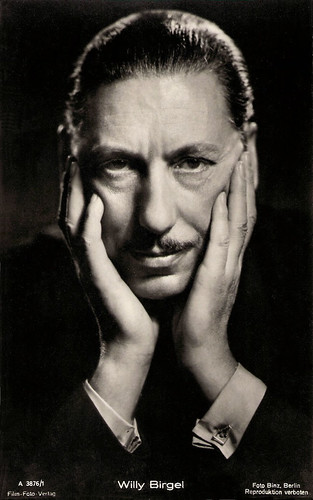
German postcard by Film-Foto-Verlag, no. A 3876/1. Photo: Ufa / Binz, Berlin.
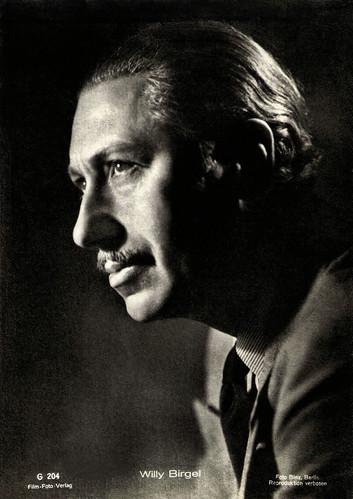
German postcard by Film-Foto-Verlag, no. G 204, 1941-1944. Photo: Binz.
Sources: Wikipedia, Deutsches Historisches Museum (German), Thomas Staedeli (Cyranos), Miss Mertens (Flickr) and IMDb.

German postcard by Ross Verlag, no. A 2991/1, 1939-1940. Photo: Bavaria Filmkunst.

German postcard by Film-Foto-Verlag, no. A 3617. Photo: Ufa / Binz.

German postcard by Film-Foto-Verlag, no. A 3659/2. Photo: Ufa / Binz.
Staatsschauspieler
Wilhelm Maria (Willy) Birgel was born in 1891, in Köln (Cologne), Germany. He was the son of Johann Heinrich Birgel, a goldsmith and engraver, and his wife Henriette (born Dreyers).
Willy began his acting career in 1912 on the stage in Köln. In the following years he played in theatres in Bonn, Dessau, Köln and Koblenz. The first World War interrupted in 1915 his career and he was wounded while serving with a German artillery unit in Serbia. After the war he continued his stage career in the theatre of Aachen. In 1924 he became a company member of the Nationaltheater of Mannheim, where he had triumphs with roles like Faust and Mephistopheles in Goethe’s Faust I, Franz Moor in Schiller’s Die Räuber/The Robbers and the title characters in Shakespeare’s Hamlet and Richard III.
His film debut came rather late. He was already over forty years old before he got his first major film role as the English Camp Commandant in Ein Mann will nach Deutschland/A Man Wants to Get to Germany (Paul Wegener, 1934). This Ufa-production portrayed a German engineer (Karl Ludwig Diehl) living in South America who hears in 1914 of the war in Europe. He has only one thought: home to Germany to help a fatherland under attack. The film showed of the kind of German values that were emphasized in Nazi Germany.
Other films he made for the National Socialist Regime included Unternehmen Michael/The Private's Job (Karl Ritter, 1937), Feinde/Enemies (Viktor Tourjansky, 1940) with Brigitte Horney, and Kameraden/Comrades (Hans Schweikart, 1941). In 1937, Reichspropagandaminister Joseph Goebbels named Birgel Staatsschauspieler (Actor of the State), the highest honor for German actors at the time. Beside the propaganda films, he starred in several popular entertainment films becoming an unlikely public favorite.
Birgel had his first leading part in Fürst Woronzeff/Prince Woronzeff (Artur Robison, 1934). He appeared as a chivalrous aristocrat and distinguished gentleman in Das Mädchen Johanna/Joan of Arc (Gustav Ucicky, 1935) with Gustaf Gründgens and Heinrich George, in Schlussakkord/Final Accord (Detlev Sierck/Douglas Sirk, 1936) with Lil Dagover, and in Fanny Elssler (Paul Martin, 1937) with Lilian Harvey. Great successes were Zu neuen Ufern/To New Shores (Detlev Sierck/Douglas Sirk, 1937) and Der Blaufuchs/The Blue Fox (Viktor Tourjansky, 1938), both in which he appeared at Zarah Leander's side.
Meanwhile he also had success on stage at the Berliner Volksbühne. Till the end of the war he continued his career with films like Der Fall Deruga/The Deruga Case (Fritz Peter Buch, 1938), Maria Ilona (Géza von Bolváry, 1939) opposite Paula Wessely, Das Herz der Königin/The Heart of a Queen (Carl Froelich, 1940) with Zarah Leander, ...reitet für Deutschland/Riding for Germany (Arthur Maria Rabenalt, 1941), the Rudolf Diesel biography Diesel (Gerhard Lamprecht, 1942), and Der Majoratsherr (Hans Deppe, 1944).

German postcard by Film-Foto-Verlag, no. A 3659/1, 1941-1944. Photo: Ufa / Binz.

German postcard by Das Illustrierte Blatt. Photo: Ufa / Lindner. Publicity still for Das Herz der Königin/Mary Queen of Scots (Carl Froelich, 1940) with Lotte Koch.

German postcard by FBZ, no. 225. Photo: Merkur-Film / T. v. Mindszenty. Publicity still for Das ewige Spiel/The eternal game (Frantisek Cáp, 1951) with Cornell Borchers.
On the Allied Black-list
After World War II, Willy Birgel was on the Allied black-list and did not make another film until 1947. Director Harald Braun and producer Erich Pommer offered him a role in Zwischen gestern und morgen/ Between Yesterday and Tomorrow (Harald Braun, 1947) with Hildegard Knef.
By the 1950s, he was back on the level of his pre-war popularity. He often appeared together with superstar Hans Albers, for example in Vom Teufel gejagt/Hunted by the Devil (Viktor Tourjansky, 1950). He specialized in supporting roles as the elderly grand seigneur and also of the father figure, and appeared in many Heimatfilms, for example Heidi (Luigi Comencini, 1952), and Johannisnacht/Midsummer Night (Harald Reinl, 1956) with Hertha Feiler.
In the 1960s, Birgel was able to make the transition to television. In the cinema he was seen in films like Frau Cheneys Ende/The End of Mrs. Cheney (Franz Josef Wild, 1961) with Lilli Palmer, and Sommersprossen/Beyond Control (Helmut Förnbacher, 1968). Interesting was Schonzeit für Füchse/No Shooting Time for Foxes (Peter Schamoni, 1966) in which Birgel made fun of his own image. The film won the Silver Bear of the Berlin Film Festival.
In 1966 Birgel himself won the Bundesfilmpreis, a honorary award for his continued outstanding individual contributions to the German film over the years. He was also awarded the Bambi award in 1960 and the Filmband im Gold award in 1964 and 1966. His last film was the Italian film Il Gesto/The Gesture (Marcello Grottesi, 1973).
Willy Birgel died in 1973 of heart failure, in Dübendorf, Zürich, Switzerland. He was buried in his birth city, Köln. Birgel was married twice: first to actress Carola Cajetan, with whom he had a son, and later to actress Charlotte Michael, with whom he had a daughter. Both his marriages ended in a divorce.
I loved this comment by Miss Mertens at one of our postcards at Flickr : "From my mother I know, that it was the biggest compliment in the 1940s, when somebody told a man: 'You are looking like Willy Birgel'."

German postcard by Werbedrück Rudolf Stepanek, München. Photo: Gloria / Lilo. Publicity still for Sterne über Colombo/Stars Over Colombo (Veit Harlan, 1953) and Die Gefangene des Maharadscha/Circus Girl (Veit Harlan, 1954).

German postcard by Film-Foto-Verlag, no. A 3876/1. Photo: Ufa / Binz, Berlin.

German postcard by Film-Foto-Verlag, no. G 204, 1941-1944. Photo: Binz.
Sources: Wikipedia, Deutsches Historisches Museum (German), Thomas Staedeli (Cyranos), Miss Mertens (Flickr) and IMDb.
No comments:
Post a Comment